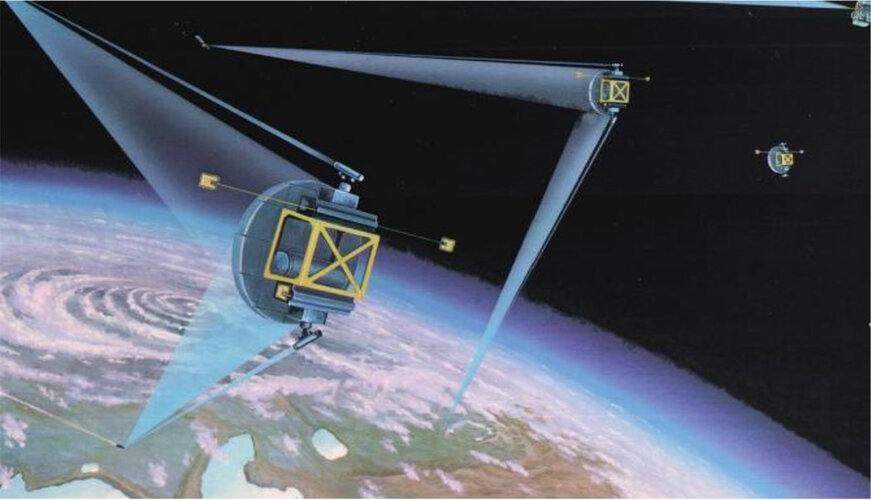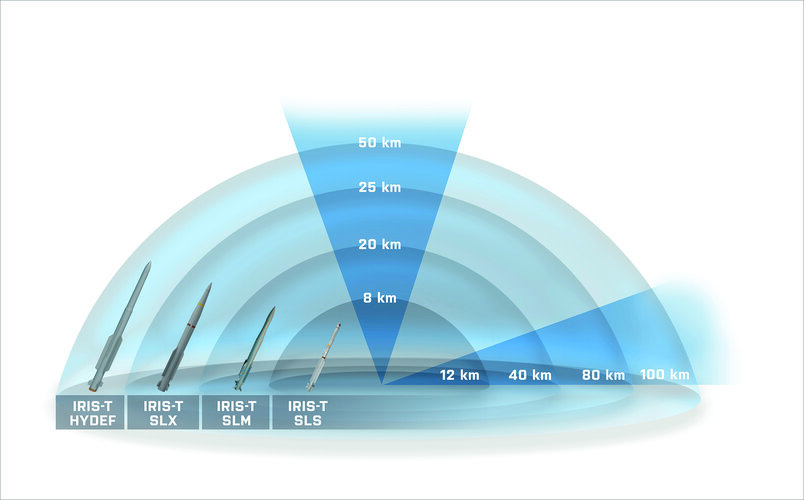- Joined
- 3 June 2011
- Messages
- 18,327
- Reaction score
- 12,193
I think it's just the Army Typhon launcher for the Tomahawk/SM-6 (mobile Mk41 VLS).What’s the “Exhibitionary Weapon”?
I think it's just the Army Typhon launcher for the Tomahawk/SM-6 (mobile Mk41 VLS).What’s the “Exhibitionary Weapon”?






 www.opex360.com
www.opex360.com
Leader of the European program [Timely Warning and Interception with Space-based Theater surveillance] which, financed by the European Union [EU] under the Permanent Structured Cooperation [CSP or PESCO], aims to develop a defense system against hypersonic missiles, MBDA France had all the cards in hand to be appointed coordinator of another related project, namely the European Hypersonic Defense Interceptor [EU HYDEF]. Especially since the industrialist had just launched his interceptor missile project, called AQUILA

Following tomorrow's launch, those first ten satellites - eight of which are "transport layer" satellites and two of which are "tracking layer" satellites - will undergo calibration and their efficacy will also be evaluated with a series of tests.

It still has a boost phase though. Hit the booster before separation but you won't do that with an interceptor."designed to shoot down hypersonic missiles before they begin the high-speed maneuvers that make them hard to engage, according to a senior MDA official."
"As the name suggests, the GPI program is aimed at knocking down hypersonic missiles during the glide phase of flight when the hypersonic warhead is skimming space before it reenters the atmosphere (wtf?) — the longest phase of flight between launch and “terminal” phase."
Well something doesn't add up. It's called GLIDE phase intercept but the target doesn't "glide" in space. Hell, it may never even reach space. The BGRV didn't. It flew 5000nm all well within the atmosphere.
The thing with these HGVs and MaRVs is that they don't necessarily know when to manoeuvre. A HGV doesn't necessarily know an interceptor is about to hit it unless it's kitted out with a full EW suite. Is that likely?I think it’s just poor phrasing on the writers part. I’m assuming that DoD thinks boost gliders will hold a steady course and speed because to do otherwise reduces the speed and range of the glider.
BGRV PEAKED at 130,000ft. A glider never needs to go to space.It still has a boost phase though. Hit the booster before separation but you won't do that with an interceptor."designed to shoot down hypersonic missiles before they begin the high-speed maneuvers that make them hard to engage, according to a senior MDA official."
"As the name suggests, the GPI program is aimed at knocking down hypersonic missiles during the glide phase of flight when the hypersonic warhead is skimming space before it reenters the atmosphere (wtf?) — the longest phase of flight between launch and “terminal” phase."
Well something doesn't add up. It's called GLIDE phase intercept but the target doesn't "glide" in space. Hell, it may never even reach space. The BGRV didn't. It flew 5000nm all well within the atmosphere.
Not a lot of sense made because a non-glide phase interceptor can hit it in space.



Have to say, the range surprises me, because Atlas had a range of <8000nm even on a minimum energy trajectory, but nonetheless the GPI article made no sense. With HGVs, more and more the solution seems to come back to lasers. You would need some space based assets plus some ground based assets as a back up, along with a relay mirror system in case an enemy tries to use their own ground-based laser to damage your space-based ones.BGRV PEAKED at 130,000ft. A glider never needs to go to space.
View attachment 698701
View attachment 698700
The thing with these HGVs and MaRVs is that they don't necessarily know when to manoeuvre. A HGV doesn't necessarily know an interceptor is about to hit it unless it's kitted out with a full EW suite. Is that likely?I think it’s just poor phrasing on the writers part. I’m assuming that DoD thinks boost gliders will hold a steady course and speed because to do otherwise reduces the speed and range of the glider.
The RV Atlas achieved 8000nm+ with was likely lighter than BGRV also it was traveling in space with little to no friction. BGRV would have been fighting drag so much it would have been glowing the entire way. That takes energy.Have to say, the range surprises me, because Atlas had a range of <8000nm even on a minimum energy trajectory, but nonetheless the GPI article made no sense. With HGVs, more and more the solution seems to come back to lasers. You would need some space based assets plus some ground based assets as a back up, along with a relay mirror system in case an enemy tries to use their own ground-based laser to damage your space-based ones.BGRV PEAKED at 130,000ft. A glider never needs to go to space.
View attachment 698701
View attachment 698700


And, after a while of degrading its speed and hence performance, it becomes an easier target for interceptors.Oh definitely, and moreover I assume the drag penalties for maneuvering earlier in flight increase in a non linear fashion. The glider would have to be preset to start taking evasive maneuvers while roughly maintaining a baseline course to the target to make GPI engagements more difficult-which is going to penalize range and speed. To some extent I think GPI is an effort to decrease range or force the incoming out of the hypersonic envelope for easier terminal engagement as much as actually achieve kills.
I read an article about the 2017 CPS test that indicated the glider traveled 2200 miles in under 30 minutes- though I can no longer find any source to quote for those numbers. When did the math I think that was roughly an average of Mach 6. Given the logarithmic rate of deceleration, that probably means a massive double digit Mach initial speed and quite possibly a merely highly supersonic (<mach5) terminal impact. Forcing gliders to maneuver early in flight could greatly reduce performance envelope to make other defenses much more effective. Also there might be upper limits to maneuvering at all during the earliest phases of flight, depending on the glider.
??Let's also not forget about MUTANT.
??Let's also not forget about MUTANT.







By definition, irrational actors are not deterred by that. They will do what they will do, and the consequences of those actions do not matter.So... there is a missile... uh, HGV defense gap which means hundreds of defensive warheads need to be built. Good news for Defense Contractors.
Regarding irrational actors, something along the lines of, "You do X and we blow up your country." should help.
If it was possible to build a large, ground-based, solid-state phased array laser in the same form as many missile defence radars, then that would be an extremely effective terminal defence. It would need serious power, but being ground-based weight/size wouldn't be an issue.and why don't they shoot down these hypersonic rockets in the final flight somewhere at a height of 10 km, something similar to using multiple rocket launchers in order to create a cloud of explosion and shrapnel?
It's theoretically possible, but the problem is that a phased array requires emitter elements to be spaced 1/4 wavelength apart. And, I believe that's 1/4 wavelength center to center, not edge to edge, but I don't have enough references to figure that out.
With radio waves, even high frequencies like X-band, that's not hard to do. X-band has a wavelength of around 3cm, so the emitter elements are 0.75cm apart. Simple enough.
But light frequencies? 2400nm deep IR lasers means your emitters have to be 600nm apart. 0.0006 Millimeters. That is one hell of an engineering challenge! This only gets worse with less attenuated light frequencies like green (500-570nm, 125-142.5nm 1/4 wave distance) or blue (450-500nm, 112.5-125nm 1/4 wave distance).
Also, I don't know if it'd be possible to have emitters spaced X+0.25 wavelengths apart and the system still work. If it is, that would partially solve the packing issue, but very likely at a severe performance and efficiency penalty.
It may actually be better to take a step back in laser development and use a microwave phased array. That's a roughly 1cm wavelength and a 0.25cm array spacing. That would be trivial to make.
PDF No Longer Available.It's theoretically possible, but the problem is that a phased array requires emitter elements to be spaced 1/4 wavelength apart. And, I believe that's 1/4 wavelength center to center, not edge to edge, but I don't have enough references to figure that out.
With radio waves, even high frequencies like X-band, that's not hard to do. X-band has a wavelength of around 3cm, so the emitter elements are 0.75cm apart. Simple enough.
But light frequencies? 2400nm deep IR lasers means your emitters have to be 600nm apart. 0.0006 Millimeters. That is one hell of an engineering challenge! This only gets worse with less attenuated light frequencies like green (500-570nm, 125-142.5nm 1/4 wave distance) or blue (450-500nm, 112.5-125nm 1/4 wave distance).
Also, I don't know if it'd be possible to have emitters spaced X+0.25 wavelengths apart and the system still work. If it is, that would partially solve the packing issue, but very likely at a severe performance and efficiency penalty.
It may actually be better to take a step back in laser development and use a microwave phased array. That's a roughly 1cm wavelength and a 0.25cm array spacing. That would be trivial to make.
works, and holy cow they got a working phased array LIDAR!!!Try now.
Yes, and now with phased array LIDAR, the high efficiencies of fibre lasers/metastable rare gas lasers and super lightweight nuclear reactors, like those of USNC, there is the opportunity for a game changing weapon as regards missile defence that also has many other uses.works, and holy cow they got a working phased array LIDAR!!!
I was not expecting that to be done yet.
